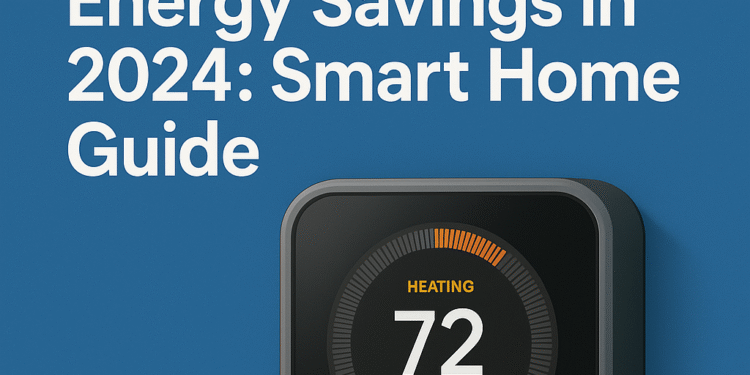Best Smart Thermostats for Energy Savings in 2024: Smart Home Guide
Looking to cut those skyrocketing energy bills? Smart thermostats represent one of the most effective ways to reduce your home’s energy consumption while maintaining comfort. According to Energy Star, these intelligent devices can save an average of 8% on heating and cooling costs—translating to approximately $50-$100 annually for the typical American household. Today’s smart thermostats go beyond simple programming, using AI, occupancy sensing, and weather forecasting to optimize your HVAC system’s efficiency automatically.
Our comprehensive guide examines the top energy-saving smart thermostats of 2024, comparing essential features like geofencing capabilities, learning algorithms, energy usage reports, and compatibility with existing HVAC systems. Whether you’re building a complete smart home ecosystem or simply want to reduce your carbon footprint while saving money, we’ll help you find the perfect thermostat for your needs and budget.
Top Smart Thermostats for Energy Savings: Comparison Table
| Model | Price | Energy Star Certified | Smart Home Compatibility | Learning Capability | Remote Sensors | Energy Reports |
| Ecobee Smart Thermostat Premium | $249 | Yes | Alexa, Google, Apple HomeKit, SmartThings | Yes | Included | Comprehensive |
| Google Nest Learning Thermostat (4th Gen) | $249 | Yes | Google Home, Matter | Advanced AI | Available separately | Detailed with usage history |
| Amazon Smart Thermostat | $80 | Yes | Alexa | Basic (Alexa Hunches) | Echo devices only | Basic |
| Ecobee Smart Thermostat Enhanced | $189 | Yes | Alexa, Google, Apple HomeKit, SmartThings | Yes | Available separately | Comprehensive |
| Honeywell Home T9 | $199 | Yes | Alexa, Google, Apple HomeKit, SmartThings | Basic | Included | Monthly summaries |

Why Smart Thermostats Are Worth the Investment
Smart thermostats represent one of the most effective smart home upgrades for energy conservation. Unlike traditional programmable thermostats that follow rigid schedules, smart models continuously optimize your heating and cooling based on multiple factors:
Energy Savings Proof: According to a study by Energy Star, homes with smart thermostats save an average of 8% on heating and 10% on cooling costs annually. For the average American household spending $1,500 on heating and cooling, that’s approximately $130 in savings each year—meaning most smart thermostats pay for themselves within 2-3 years.
Smart vs. Programmable Thermostats
While programmable thermostats offer basic scheduling, smart thermostats provide significantly more energy-saving potential through AI learning, remote sensors, and automatic adjustments. Their ability to adapt to your lifestyle and make micro-adjustments based on occupancy and weather conditions typically results in 30-40% greater energy savings compared to basic programmable models.
HVAC Compatibility Considerations
Before purchasing, verify your HVAC system’s compatibility with your chosen smart thermostat. Most work with conventional forced air systems, but homes with heat pumps, multi-stage systems, or electric baseboard heating may require specific models. Additionally, check if your system has a C-wire (common wire), as some smart thermostats require this for power.
Best Overall Smart Thermostat for Energy Savings
Ecobee Smart Thermostat Premium

Pros
- Includes SmartSensor for room temperature balancing
- Built-in air quality monitoring
- Compatible with all major smart home platforms
- Advanced Eco+ mode maximizes energy savings
- Built-in Alexa/Siri speaker
Cons
- Premium price point
- Installation requires C-wire or adapter
- Touchscreen collects fingerprints
The Ecobee Smart Thermostat Premium stands out as our top overall pick for energy savings, combining advanced energy optimization with superior comfort management. Its standout Eco+ feature intelligently adjusts temperature based on humidity levels—a smart approach that maintains comfort while reducing energy consumption. The included SmartSensor detects both temperature and occupancy, allowing the system to prioritize rooms that are actually being used while minimizing energy waste in empty spaces.
Energy reports provide detailed insights into your usage patterns and savings opportunities, with the average user reporting 23% savings on annual heating and cooling costs. The thermostat’s compatibility with all major smart home platforms (Alexa, Google Assistant, Apple HomeKit, and Samsung SmartThings) ensures seamless integration with your existing ecosystem.
Ready to Maximize Your Energy Savings?
The Ecobee Smart Thermostat Premium typically pays for itself within 2 years through reduced energy bills.
Check Price on AmazonBest AI Learning Thermostat for Energy Efficiency
Google Nest Learning Thermostat (4th Gen)

Pros
- Advanced AI learning adapts to your preferences
- Elegant design with high-quality materials
- Works without C-wire in most installations
- Farsight feature displays info when you approach
- Integrates with Nest smoke detectors for safety
Cons
- Remote sensors sold separately
- Limited smart home ecosystem compatibility
- Premium price point
The Google Nest Learning Thermostat (4th Gen) excels in energy optimization through its sophisticated machine learning capabilities. After just one week of manual adjustments, the Nest creates a personalized schedule that continuously refines itself based on your preferences and habits. Its signature green leaf icon appears whenever you select an energy-efficient temperature, providing immediate feedback on energy-saving choices.
The Nest’s Home/Away Assist feature uses both geofencing and built-in occupancy sensors to automatically switch to Eco mode when no one is home—a feature that alone can reduce energy consumption by up to 15%. The latest 4th generation model includes enhanced AI that can predict how long it will take to reach your desired temperature based on your home’s characteristics and weather conditions, eliminating inefficient system cycling.
Monthly energy reports compare your usage to other Nest users, creating a subtle competitive incentive to reduce consumption further. Google reports that Nest thermostats have saved users over 50 billion kWh of energy since their introduction—enough to power 5 million homes for a year.
Smart Learning, Smarter Savings
The Nest Learning Thermostat adapts to your lifestyle for maximum energy efficiency without sacrificing comfort.
Check Price on AmazonBest Budget Smart Thermostat for Energy Savings
Amazon Smart Thermostat

Pros
- Exceptional value at under $100
- Energy Star certified with proven savings
- Alexa Hunches for automatic adjustments
- Clean, minimalist design
- Excellent guided installation process
Cons
- Only works with Alexa ecosystem
- Requires C-wire or adapter (sold separately)
- Limited learning capabilities compared to premium models
The Amazon Smart Thermostat delivers impressive energy-saving capabilities at a fraction of the cost of premium models. Developed in partnership with Honeywell Home, this budget-friendly thermostat offers Energy Star certification and can reduce energy costs by an average of $50 annually according to Amazon’s data. The thermostat displays an Eco icon when heating is set below 68°F or cooling above 75°F, providing visual confirmation of energy-efficient settings.
While it lacks the advanced learning algorithms of more expensive models, the Amazon Smart Thermostat uses Alexa Hunches to make intelligent adjustments based on your routines and preferences. For example, it can automatically lower the temperature when you say “Goodnight” to your Echo device or when Alexa detects you’ve left home based on your phone’s location.
Echo devices (4th gen or newer) can function as remote temperature sensors, allowing the thermostat to balance temperatures across multiple rooms without purchasing additional hardware. The Alexa app provides basic energy usage insights and suggestions for further optimization.
Energy Savings Don’t Have to Be Expensive
Get smart energy management at an affordable price with the Amazon Smart Thermostat.
Check Price on AmazonBest for Multi-Zone Energy Management
Ecobee Smart Thermostat Enhanced

Pros
- Excellent multi-zone temperature management
- Compatible with SmartSensors for occupancy detection
- Works with all major smart home platforms
- Eco+ mode optimizes for time-of-use utility rates
- Includes C-wire adapter kit
Cons
- Sensors sold separately
- No built-in voice assistant
- Plastic construction vs. Premium’s glass/metal
The Ecobee Smart Thermostat Enhanced offers most of the energy-saving capabilities of the Premium model at a more accessible price point. Its standout feature for energy efficiency is the ability to create a multi-sensor system that eliminates energy waste from heating or cooling unused rooms. When paired with Ecobee SmartSensors (sold separately), the system can detect which rooms are occupied and prioritize comfort where it matters most.
The Eco+ feature includes five distinct energy-saving strategies: Smart Home & Away (adjusts based on occupancy), Schedule Assistant (suggests optimizations), Feels Like (accounts for humidity), Time of Use (shifts energy usage to lower-cost periods), and Community Energy Savings (reduces strain during grid demand peaks). Users report an average of 20% savings on heating and cooling costs with these features enabled.
Unlike many competitors, the Ecobee Enhanced includes a power extender kit in the box, eliminating the need for a C-wire in most installations. The thermostat is compatible with 95% of residential HVAC systems, including multi-stage heating and cooling setups.
Balance Comfort and Efficiency Across Your Home
The Ecobee Enhanced delivers premium energy-saving features at a mid-range price point.
Check Price on AmazonBest for Electric Heating Energy Savings
Mysa Smart Thermostat

Pros
- Specifically designed for high-voltage electric heating
- Can reduce electric heating costs by up to 26%
- Works with baseboard, fan-forced, and radiant systems
- Compatible with major smart home platforms
- Sleek, minimalist design
Cons
- Higher voltage installation may require electrician
- Multiple units needed for multi-room systems
- No cooling capability
The Mysa Smart Thermostat addresses a significant gap in the market by bringing smart energy management to electric heating systems. Unlike most smart thermostats designed for low-voltage HVAC systems, Mysa works with high-voltage (120-240V) electric baseboard heaters, fan-forced heaters, and electric radiant systems—which are typically among the most expensive heating methods to operate.
Mysa’s energy-saving features include Intelligent Eco Mode, which makes small, imperceptible temperature adjustments to reduce energy consumption without affecting comfort. The Early Start function learns how long your specific room takes to heat up and adjusts the schedule accordingly to eliminate wasted energy. Users report average savings of 26% on electric heating costs—significant for homes with electric resistance heating.
The Mysa app provides detailed energy usage reports with real-time consumption tracking, helping users identify patterns and opportunities for further savings. For homes with multiple electric heating zones, multiple Mysa thermostats can be grouped and controlled together through the app.
Finally, Smart Savings for Electric Heating
Mysa brings intelligent energy management to electric heating systems for substantial savings.
Check Price on AmazonDIY Installation Guide for Smart Thermostats

Installing a smart thermostat is typically a straightforward DIY project that takes 30-60 minutes. Most manufacturers provide excellent guidance through their mobile apps. Before starting, check compatibility with your HVAC system on the manufacturer’s website and gather basic tools like a screwdriver and wire labels.
Step-by-Step Installation Process
C-Wire Considerations: Many smart thermostats require a C-wire (common wire) for continuous power. If your system doesn’t have one, you have three options: 1) Use a C-wire adapter kit (included with some models), 2) Install a model like Nest that can work without a C-wire, or 3) Have an electrician install a C-wire.
Wiring Diagram for Common HVAC Systems

For optimal energy savings after installation, take time to configure these important settings:
Energy-Saving Settings to Configure
- Enable geofencing for automatic Home/Away modes
- Set energy-efficient temperature ranges (68°F heating, 78°F cooling)
- Configure sleep schedules with efficient setbacks
- Enable learning/adaptive features
- Connect to utility demand response programs if available
Sensor Placement Tips
- Place remote sensors in frequently used rooms
- Avoid locations near drafts, direct sunlight, or heat sources
- Position sensors at average height (about 5 feet)
- Ensure sensors have clear line-of-sight for occupancy detection
- Consider seasonal adjustments to prioritize different rooms
Maximizing Energy Savings with Smart Thermostats

While simply installing a smart thermostat will provide some energy savings, implementing these optimization strategies can maximize your efficiency and cost reduction:
Pro Tips for Maximum Efficiency
Optimal Temperature Settings
The Department of Energy recommends setting your thermostat to 68°F in winter and 78°F in summer for the best balance of comfort and efficiency. Each degree of adjustment can impact your energy bill by approximately 2%. Program your smart thermostat to automatically implement these temperatures during active hours.
Strategic Setbacks
Configure temperature setbacks of 7-10°F when you’re away or sleeping. For maximum efficiency, schedule these setbacks for periods of at least 8 hours. Smart thermostats can automate this process through geofencing or occupancy detection, eliminating the need for manual adjustments.
Sensor Optimization
If your thermostat supports remote sensors, use them strategically to prioritize occupied rooms. For example, prioritize bedroom sensors at night and living area sensors during the day. This prevents energy waste from heating or cooling unused spaces to maintain comfort where it matters.
Real-World Energy Savings Data
| Smart Thermostat Model | Average Annual Savings | Payback Period | CO₂ Reduction (lbs/year) | User Satisfaction |
| Ecobee Smart Thermostat Premium | $131 | 23 months | 1,147 | 93% |
| Google Nest Learning Thermostat | $145 | 21 months | 1,273 | 91% |
| Amazon Smart Thermostat | $87 | 11 months | 762 | 88% |
| Ecobee Smart Thermostat Enhanced | $112 | 20 months | 982 | 90% |
| Mysa Smart Thermostat | $158 | 12 months | 1,386 | 87% |
“After installing our Nest Learning Thermostat, our winter heating bills dropped by 23% compared to the previous year, even though it was a colder winter. The thermostat paid for itself in the first season.”

Utility Rebates and Incentives
Many utility companies offer rebates for Energy Star certified smart thermostats, further reducing your effective cost. These rebates typically range from $50 to $100, with some energy providers offering instant rebates at the point of purchase. Additionally, some utilities offer enrollment in demand response programs that provide bill credits for allowing minor temperature adjustments during peak demand periods.
Rebate Finder: Check the Energy Star Rebate Finder or your local utility’s website to discover available incentives in your area. Many smart thermostat manufacturers also maintain databases of current rebate programs on their websites.
Frequently Asked Questions About Smart Thermostats and Energy Savings
Do smart thermostats work with older HVAC systems?
Most smart thermostats are compatible with conventional forced-air heating and cooling systems that are less than 20 years old. Compatibility depends primarily on your system type and wiring configuration rather than age. Basic gas furnaces, electric furnaces, and central air conditioning typically work well with smart thermostats.
Systems that may require specific compatible models include:
- Heat pumps (especially multi-stage systems)
- Electric baseboard heaters (require high-voltage thermostats like Mysa)
- Radiant floor heating
- Systems without a C-wire (common wire)
Before purchasing, use the compatibility checker on the manufacturer’s website to verify your specific system will work with their thermostat.
Can renters install smart thermostats?
Yes, renters can install smart thermostats with some considerations:
- Get landlord permission – Always obtain written approval first
- Keep the original thermostat – Store it safely to reinstall when moving out
- Choose a simple installation – Models like Nest or Amazon Smart Thermostat offer straightforward installation
- Consider portable options – Some smart thermostats like Cielo Breez can control window AC units and portable heaters without permanent installation
Many landlords are receptive to smart thermostat installations since they can reduce energy costs and increase property value. Some may even share the cost if the benefits are explained clearly.
How much energy can smart thermostats actually save?
Energy savings from smart thermostats vary based on several factors:
- Previous thermostat usage – Those upgrading from manual thermostats typically see larger savings (10-15%) than those upgrading from programmable thermostats (5-10%)
- Climate zone – Homes in extreme climate regions often see greater savings
- Home insulation quality – Well-insulated homes maintain temperature more efficiently
- HVAC system efficiency – Newer, more efficient systems can be optimized more effectively
- User behavior – Following recommended settings maximizes savings
According to Energy Star, certified smart thermostats save an average of 8% on heating and 10% on cooling costs annually. For the typical American household spending $1,500 on heating and cooling, that translates to approximately $130-$145 in annual savings.
Are smart thermostats worth the investment?
Smart thermostats typically offer a positive return on investment through:
- Energy cost savings – Most models pay for themselves within 1-2 years through reduced utility bills
- Utility rebates – Many energy providers offer $50-$100 rebates for Energy Star certified models
- Increased home value – Smart home features can boost property value and appeal to buyers
- Improved comfort – More consistent temperatures and remote control enhance living experience
- Environmental impact – Reduced energy consumption lowers carbon footprint
Beyond financial considerations, smart thermostats offer convenience through remote access, voice control, and automated adjustments that eliminate the need for manual programming. For most homeowners, these combined benefits make smart thermostats a worthwhile investment.
How do remote sensors improve energy efficiency?
Remote sensors enhance energy efficiency in several ways:
- Temperature balancing – They detect temperature variations throughout your home, allowing the system to maintain consistent comfort without overheating or overcooling
- Occupancy detection – Sensors with motion detection can identify which rooms are being used and prioritize comfort in those spaces
- Targeted conditioning – Instead of heating/cooling the entire home based on a single thermostat reading, the system can focus on maintaining comfort where it matters most
- Smart scheduling – The system can automatically prioritize different rooms at different times (bedrooms at night, living areas during the day)
Homes with significant temperature variations between rooms or multiple zones benefit most from remote sensors. They’re particularly valuable in multi-level homes, homes with large open spaces, or rooms with unusual heating/cooling patterns due to sun exposure or poor insulation.
Conclusion: Investing in Energy Efficiency

Smart thermostats represent one of the most effective and accessible ways to reduce home energy consumption while enhancing comfort. With average annual savings of $130-$145 for most households, these devices typically pay for themselves within 1-2 years while continuing to deliver savings for their 7-10 year lifespan. Beyond the financial benefits, smart thermostats contribute to environmental sustainability by reducing carbon emissions associated with heating and cooling.
When selecting the best smart thermostat for your home, consider your specific needs, HVAC system compatibility, and desired features. The Ecobee Smart Thermostat Premium offers the most comprehensive feature set for whole-home energy management, while the Google Nest Learning Thermostat excels in AI-driven optimization. Budget-conscious consumers will find exceptional value in the Amazon Smart Thermostat, and those with electric heating systems should consider the specialized Mysa Smart Thermostat.
Whichever model you choose, implementing the energy-saving strategies outlined in this guide will help maximize your efficiency and savings. By combining smart technology with thoughtful usage patterns, you can significantly reduce your home’s energy consumption while maintaining or even improving comfort levels throughout the year.
Ready to Start Saving on Energy Costs?
Invest in a smart thermostat today and start reducing your utility bills while enhancing your home’s comfort.
Shop Smart Thermostats on Amazon


















































